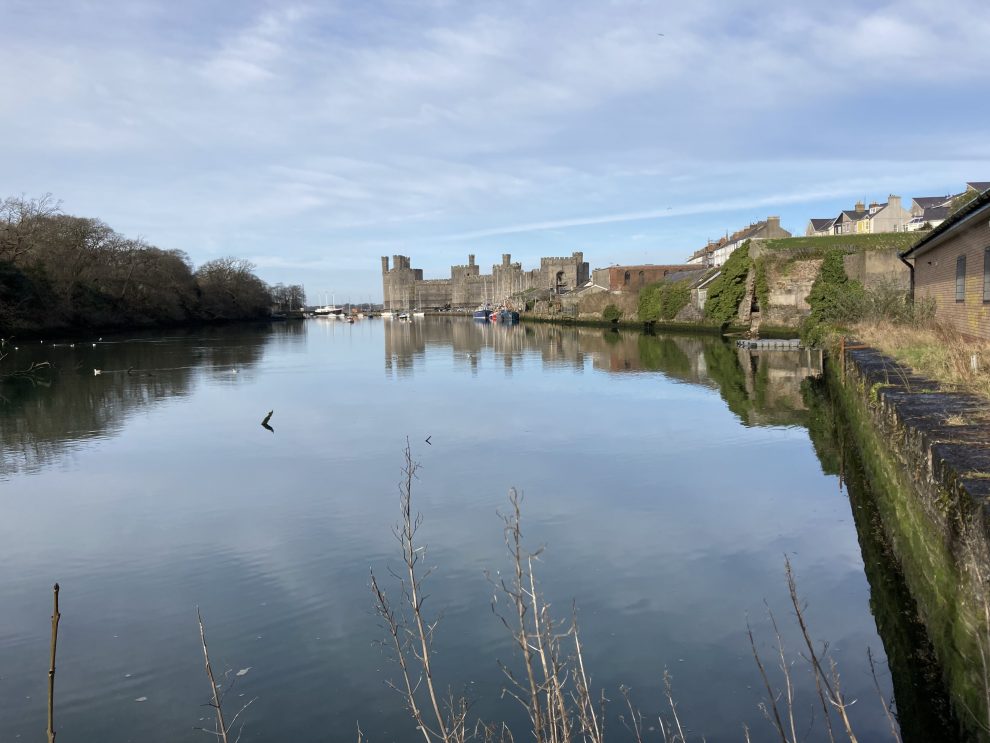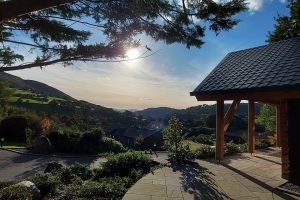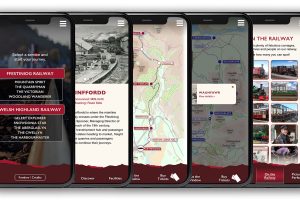THIS is a walk all about “learning to read the landscape” we were reliably informed by our affable guide.
I’d joined Gwynedd’s legendary archaeologist, tour guide, BBC radio show host, and former punk rocker Rhys Mwyn who was leading a walk around the edges of Caernarfon.
I must admit, I was a bit apprehensive.
A 3-4 hour walk sounded like a grueller – particularly for one who’s longest walk recently has probably been to the kettle and back.
But, with a post pandemic paunch to push off, and heartened by the unexpected Sunday sunshine I set off with my ‘just in case’ waterproofs’ ‘and a pile of cheese and beetroot butties safely stashed in my rucksack.
The event promised an interesting exploration of Caernarfon’s historical and often overlooked features.
It would take in some of Caernarfon’s history, interesting place names, industrial heritage, Romans, river crossings and some forgotten heroes.
It offered a a chance to meet new people, get some much needed exercise and a chat in Welsh.
The walk started from the Maes, we gathered at 11am, under the defiant, raised, clenched fist (clearly angry at a seagull perched on his head) of the famous politician and former Welsh Prime Minister David Lloyd George.
Moving a few steps towards Rhes Segontium, the terrace which carries the name of the nearby Roman Fort, was our first official stop.
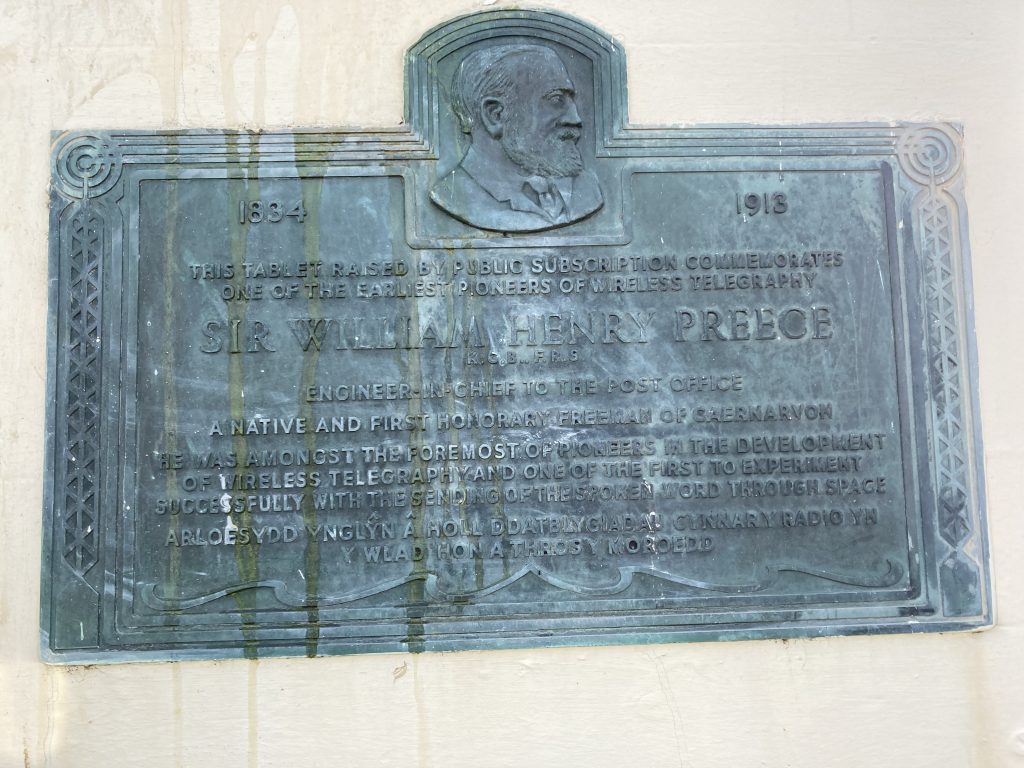
We gathered around an unassuming bronze plaque at the corner of the post office building.
Rhys explained it commemorated Sir William Preece, a little known Caernarfon-born pioneer, who played a big role in communications technology.
Preece was the General Post Office’s chief engineer and helped develop a wireless telegraphy and telephony system.
He supported of Guglielmo Marconi, who opened Britain’s first long-wave wireless transmitting station above Waunfawr.
Moving along we passed a popular hostelry, the Albert Inn.
Rhwy is a well known presenter on BBC Radio Cymru, where he presents a music themed chat show every Monday night from 7-9pm.
He was, famously, the former bass player for the punk band Anrhefin, and later managed several successful Welsh bands.
He recalled his early days organising gigs at the pub, which became popular and a melting pot for local musical talent in the late 80s.
As we walked, Rhys chatted about his life, and career, which had seen him, for several years manage several successful Welsh bands, including Catatonia.
He talked about his early meeting with the then young, but now famous musician, broadcaster, author, his friend, Cerys Matthews.
According to her website, with just under 800,000 listeners, Cerys Matthews’ Sunday morning BBC show, is biggest single show on Radio 6, and the most listened to digital shows in the UK.
“I always knew she would go on to do good things,” said Rhys.
“She was ambitious, and a talented musician, she just had that spark, something about her, you just knew she would succeed.”
We then descended the steps, across the footbridge bridge over the Welsh Highland Railway, the UK’s longest heritage railway which runs for 25 miles from Caernarfon to Porthmadog.
Dropping down onto St Helen’s Road we then passed the site of De Winton foundry and its now derelict former office.
Stopping beside the Porth y Dre hub, we looked back to see an impressive view of Caernarfon’s castle and Cei Llechi.
The castle stands out for its scale and style; use of bands of coloured stone in the walls, statues of eagles and polygonal, shaped towers.
Rhys suggests the banding design was a representation of the Walls of Constantinople.
The style was taken from the Byzantine Roman Empire, Rhys explained was an assertion of the power and authority of Edward I.
“That is a political statement right there,” Rhys said.
“The king was aligning himself in the minds of all who saw that with the idea that he was on a par with Emperor Constantine.
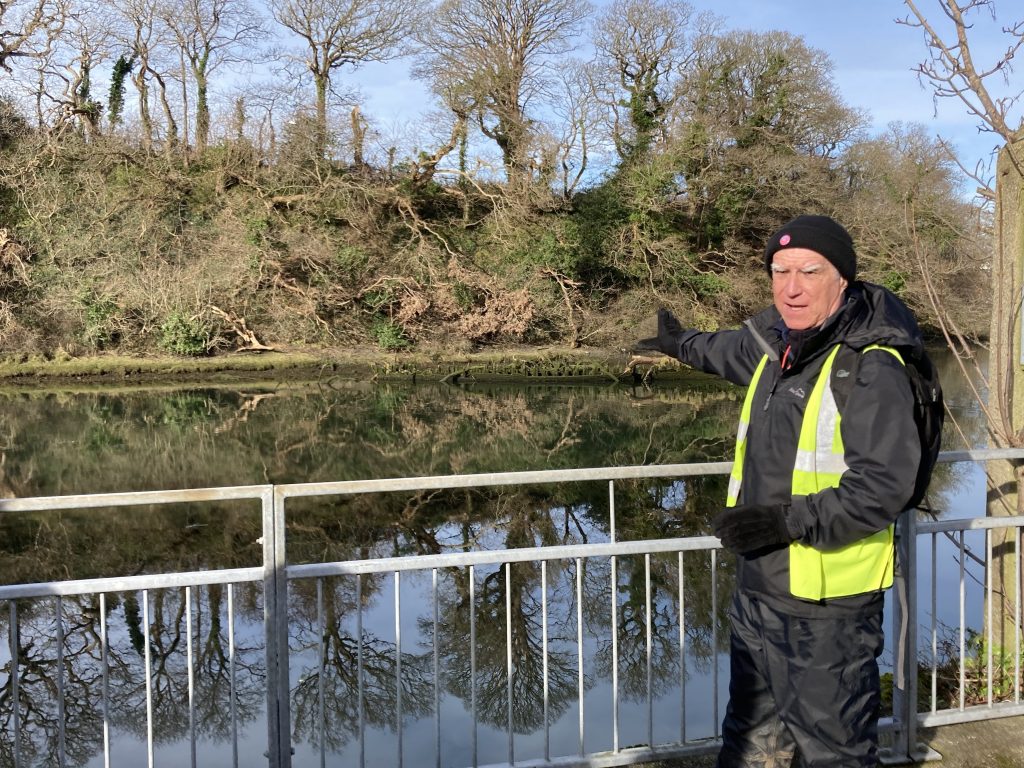
Across the water, Seiont, he pointed out the barely discernible rib bones of a shipwreck, known as the Lille, locally ‘Lily.’
Caernarfon is a town situated next to the Afon Saint/Afon Seiont (the river name is still up for debate locally) and flows into the Menai Strait.
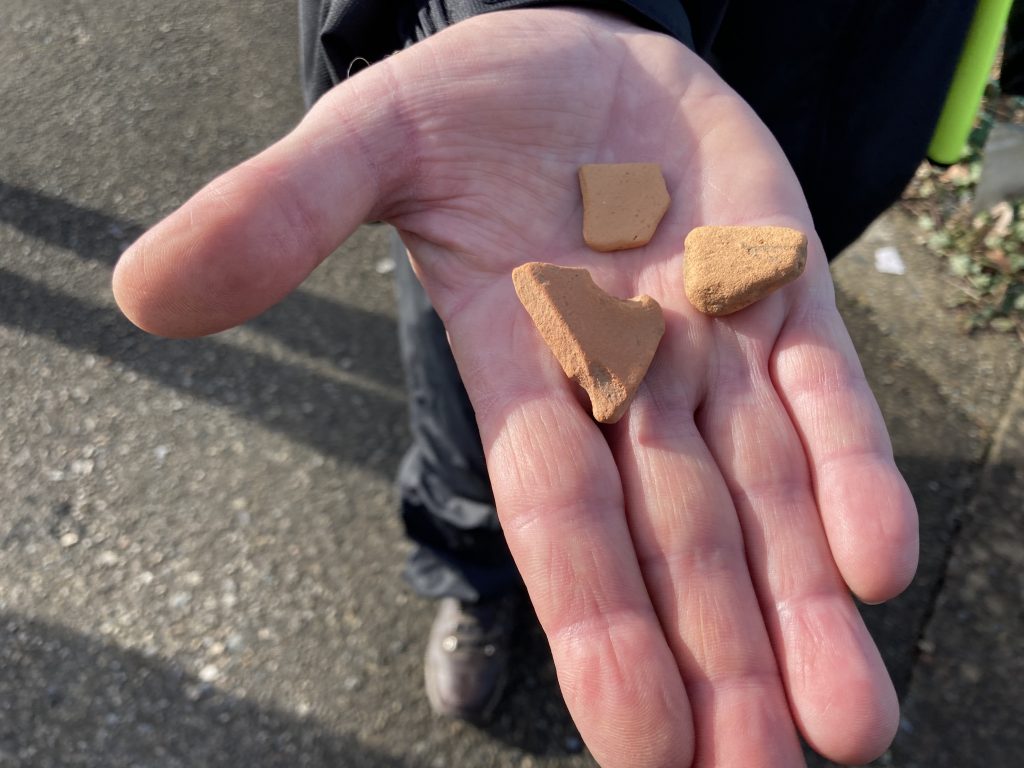
He also described an archaeological puzzle concerning the fields over the water, above, Coed Helen.
Small sherds of broken Roman pottery and pin had been found some years ago.
Archaelogists descended, including Rhys, and the area had been studied extensively, nothing was found, only a bullet, possibly from a nearby firing range.
The investigation has left the experts still pondering why the pottery pieces were there!
Debating our own theories, our by now, chatty party of walkers moved on, parallel to the WHR track.
On the opposite side of the road, Rhys pointed out the remains of a an entrance to the former Nantlle tramway.
Crossing the roundabout of the A4871, we were soon treated to more stunning views from the now disused Grade ll listed Seiont Bridge.
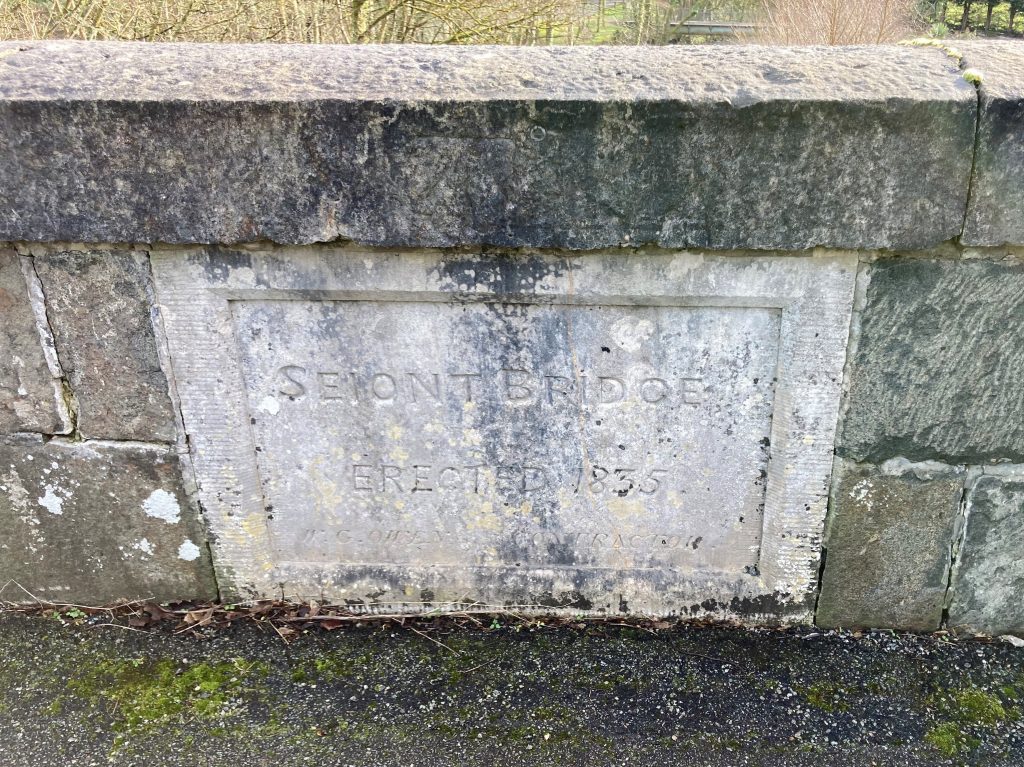
Erected in 1835, a stone plaque commemorates its long forgotten builder WG Owen, he also built parts of the road from Caernarfon to Bangor.
Along the Seiont Mill Lane, we passed several historic homes beside the river, and passed the disused entrance to the Seiont old brick works.
At the end of a residential area, we took a sharp at the last house, which saw us follow a slate lined mill race leading down to the remains of an old sluice gate, perfect for a group photo.
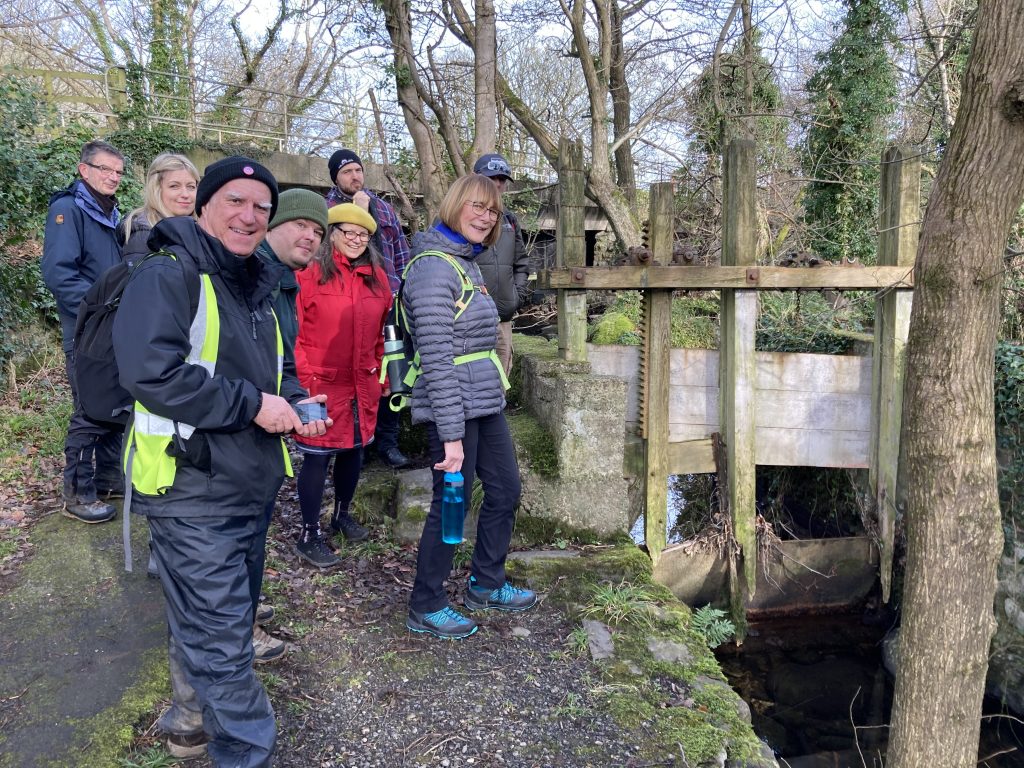
Passing through the dark, low and narrow passage under the brickwork bridge, we emerged onto a glorious riverside wooded path.
After a short trot along the tranquil path and wildlife, we stopped and eagerly tucked into our own packed lunches.
It was a peaceful and pleasant spot, and we chatted, watching the birds and listening to the water.
Along the route Rhys pointed out the footings of another long gone bridge, which would have led over to clay pits.
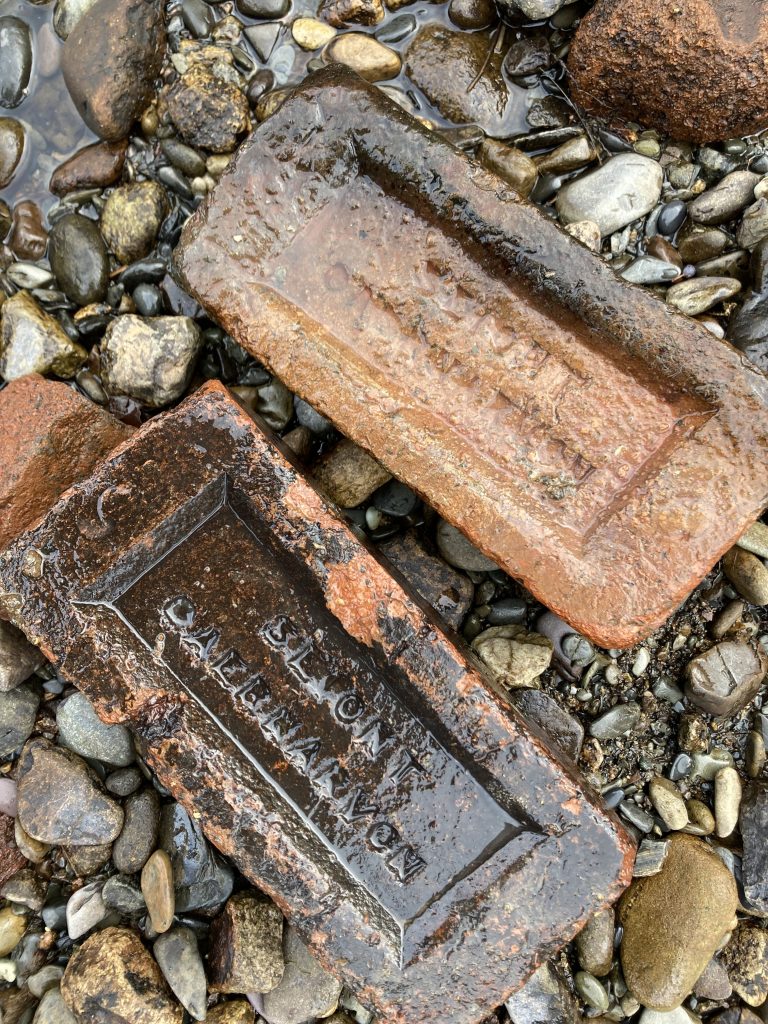
Evidence of long gone industry could be seen, with old bricks marked ‘Seiont Caernarfon’ spotted on the banks and in the water.
The flat path eventually grew narrower, and stonier, and the river banks seemed more littered, as we followed a route by a timber yard, close to the old Brunswick ironworks, now the industrial units of Peblig.
Crossing the Constantine/Waunfawr Road, the A4085, we joined a footpath, skirting cattle, a housing estate and recreation ground.
To our left was Hendre School, where archaeologists had made interesting finds during the building of the school, including a medieval cemetery, Roman ovens and Neolithic flints.
An unassuming mound, to the right of us was also identified as an ancient settlement, date unknown..
Winding through houses and the back of industrial units, we reached “the point of no return” Rhys warned.
The next leg of the journey was quite a long stint, and he advised anyone struggling to take a quicker route back, and we lost two of number.
Crossing the A4086, the rest of us ploughed on, along the flat extremely straight Ffordd Cae Garw, the descriptive name Rhys postulated could have related to a patch of unproductive land.
The dead straight road implied a Roman road, but Rhys explained it was not.
It was actually running parallel to what he described as one of the “most overlooked archaeological features in the landscape.”
With the dramatic backdrop of the Snowdonia mountains the original Roman route was across the fields on our right .
We could make out a ridge, and slight mound, which Rhys said was a Roman signal station.
He believed it was the major route between the Roman Fort, Segontium to Chester.
Turning by a farm, we headed across a lush field, dropping down to the River Cadnant, not much more than a babbling stream here and we crossed a small wooden bridge.
The water would eventually make its way through tunnels by the Victoria dock in Caernarfon.
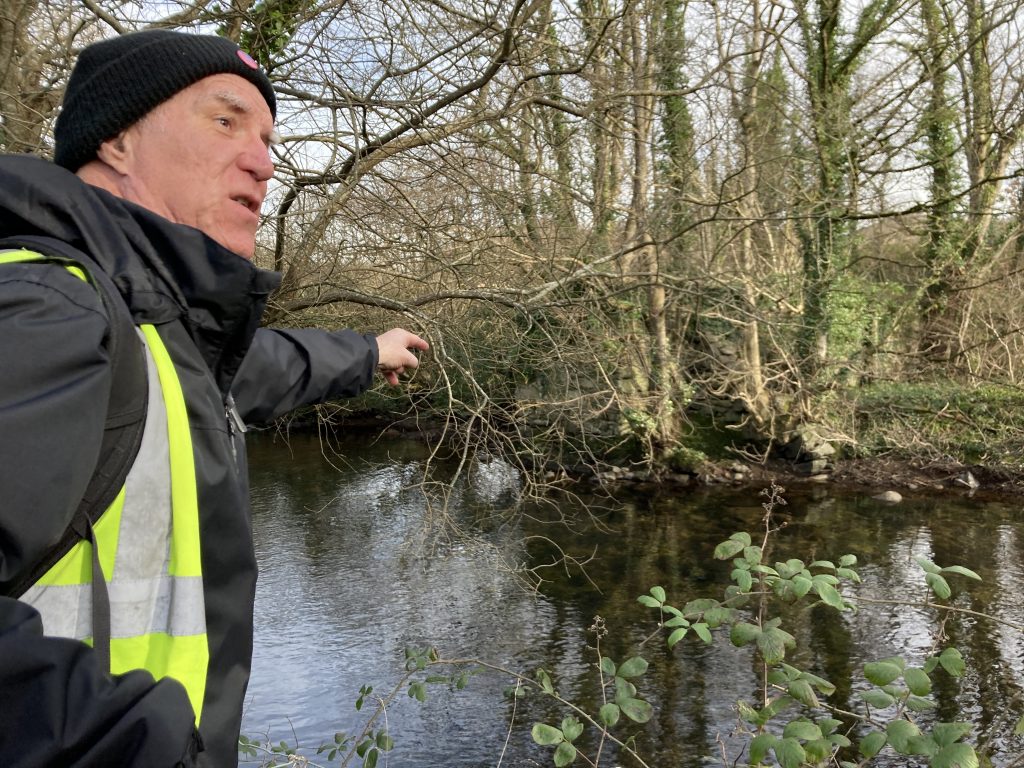
Climbing the steeply inclined muddy field, I fell behind the group having twice lost my shoe to the clawing mud!
Happily one of the party, stuck with me and we chatted and laughed as we heaved ourselves up the slope.
The path took us out onto the busy Bethel road, the B4366.
The least enjoyable part of the walk lay ahead now as we headed back towards Caernarfon on the grass verge.
Cars were screaming past, but our chatty, friendly group stuck together for protection, and we kept away from traffic.
With the town centre ahead, we skirted round the back of a swimming pool and leisure centre on Bethel Road, and gradually wound our way down through the suburban housing area of Cae Gwyn.
The route afforded superb views of the Menai Strait and across to Anglesey, and we could see the blue building of the former Mermaid Inn.
The walk ended at the carpark just below Morrison.
Stiff, tired but invigorated the walk, it had been enjoyable, in the company of my fellow walkers, all keen to meet again.
Rhys’s next walking tour, just two hours is at Beddgelert, on Saturday February 25.
The walk starts at 11am at the Bistro Hebog, Beddgelert, the itinerary includes, soup, at 1pm, price to be arranged.
There will be talk at 2pm on T H Parry Williams, of Rhydd Ddu, by Angharad Price.
There is no formal fee, but walks and events are by contribution.
Booking required, contact: [email protected]



